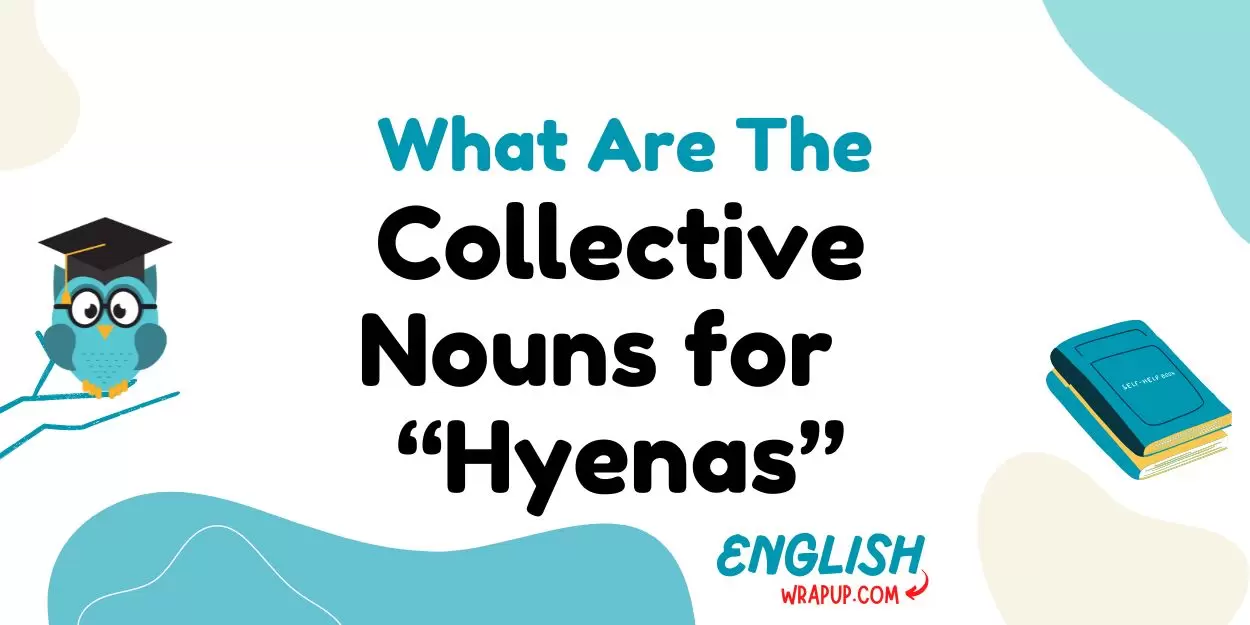Hyenas are fascinating predators known for their distinctive laughter-like vocalizations, powerful jaws, and complex social structures. These carnivores often live and hunt in groups, making them an intriguing subject for collective nouns.
In this article, we explore the collective nouns for hyenas, detailing what these terms mean and providing vivid examples of their use.
What Are Collective Nouns?
Collective nouns are words used to describe a group of individuals or things as a single entity. These nouns can refer to groups of people, animals, objects, and more. For example, a group of lions is called a “pride,” while a group of birds is known as a “flock.”
Collective nouns enrich our language by offering specific terms that encapsulate the idea of many individuals acting together as one.
Best Collective Nouns For Hyenas
- A cackle of hyenas
- A clan of hyenas
- A troop of hyenas
- A pack of hyenas
- A laugh of hyenas
- A crew of hyenas
- A band of hyenas
- A mob of hyenas
- A gang of hyenas
- A conspiracy of hyenas
Collective Nouns List
A Cackle of Hyenas
A cackle of hyenas is the most commonly used term to describe a group of hyenas, often referring to their vocalizations.
Example Scenario
In the moonlit savanna, a cackle of hyenas could be heard echoing across the plains, signaling the start of their nightly hunt.
A Clan of Hyenas
A clan of hyenas refers to a close-knit group of hyenas, often consisting of related individuals.
Example Scenario
Within the rocky den, a clan of hyenas rested after a successful hunt, their cubs playing nearby under the watchful eyes of the adults.

A Troop of Hyenas
A troop of hyenas describes a group that moves and acts together, particularly when on the move or searching for food.
Example Scenario
Across the arid desert, a troop of hyenas patrolled their territory, their keen senses alert for any signs of prey.
A Pack of Hyenas
A pack of hyenas emphasizes their cooperative hunting behavior, often seen working together to bring down larger prey.
Example Scenario
Surrounding the lone wildebeest, a pack of hyenas closed in for the kill, their coordinated movements ensuring success.
A Laugh of Hyenas
A laugh of hyenas plays on their distinctive vocalizations, likening their calls to laughter.
Example Scenario
In the dense thicket, a laugh of hyenas gathered, their eerie chuckles echoing through the night.
A Crew of Hyenas
A crew of hyenas refers to a group that works together, highlighting their teamwork and collaboration.
Example Scenario
At the waterhole, a crew of hyenas waited patiently, taking turns to drink while keeping a lookout for predators.
What Are The Collective Nouns for “Frogs”
A Band of Hyenas
A band of hyenas depicts a group that moves together, often seen traveling from one location to another.
Example Scenario
Through the dense forest, a band of hyenas journeyed, their sleek forms blending seamlessly with the shadows.
A Mob of Hyenas
A mob of hyenas describes a large, unruly group, often seen in chaotic or aggressive situations.
Example Scenario
In the midst of a territorial dispute, a mob of hyenas clashed with rival clans, their fierce growls filling the air.
A Gang of Hyenas
A gang of hyenas emphasizes their aggressive and intimidating nature, especially when confronting rivals or scavenging.
Example Scenario
Amidst the scattered bones, a gang of hyenas fought over the remains of a kill, their snarls and yips filling the night.
A Conspiracy of Hyenas
A conspiracy of hyenas is a less common but evocative term, suggesting a group working together in secret or with malicious intent.
Example Scenario
Under the cover of darkness, a conspiracy of hyenas plotted their next move, their cunning minds focused on securing their territory.

Interesting Facts About Hyenas
- Hyenas are highly intelligent predators, known for their problem-solving abilities and complex social structures.
- They have powerful jaws and teeth capable of crushing bones, allowing them to scavenge from carcasses left behind by other predators.
- Despite their reputation as scavengers, hyenas are skilled hunters and can take down prey much larger than themselves, such as wildebeest and zebras.
- There are four species of hyenas: the spotted hyena, the striped hyena, the brown hyena, and the aardwolf.
- Hyenas have a matriarchal social structure, with females typically dominating males and leading the clan.
Conclusion
Collective nouns provide a unique and fascinating way to describe groups of hyenas, enhancing our understanding and appreciation of these remarkable predators. From a cackle of hyenas calling in the night to a pack of hyenas hunting down their prey, these terms capture the essence of hyena behavior in vivid detail.
The richness of the English language is highlighted through these collective nouns, offering a glimpse into the lives of hyenas as they interact with each other and their environment. Understanding and using these terms enriches our communication and deepens our connection to the natural world.

I’m Noah Wilson, the test-prep pro at “English WRAP Up.” I’ve been helping students navigate the challenges of TOEFL, IELTS, BULATS, FCE, CAE, and PTEG, making the learning process a whole lot of fun. Over at English WRAP Up, we’re here to make your test prep incredible. Let’s wrap up your English exams with confidence and skill together!



